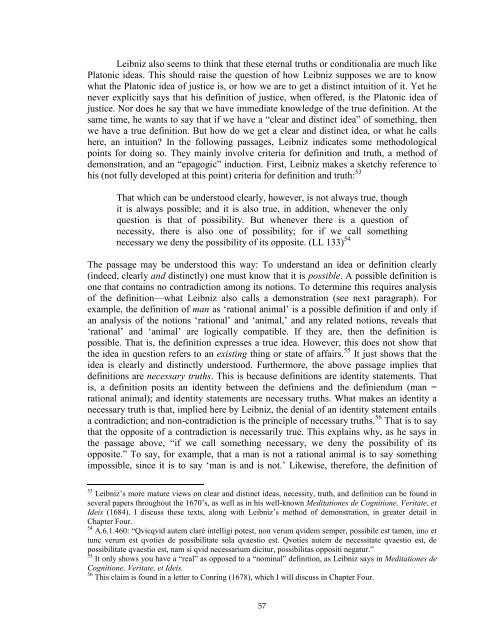Stony Brook University
Stony Brook University
Stony Brook University
You also want an ePaper? Increase the reach of your titles
YUMPU automatically turns print PDFs into web optimized ePapers that Google loves.
Leibniz also seems to think that these eternal truths or conditionalia are much like<br />
Platonic ideas. This should raise the question of how Leibniz supposes we are to know<br />
what the Platonic idea of justice is, or how we are to get a distinct intuition of it. Yet he<br />
never explicitly says that his definition of justice, when offered, is the Platonic idea of<br />
justice. Nor does he say that we have immediate knowledge of the true definition. At the<br />
same time, he wants to say that if we have a “clear and distinct idea” of something, then<br />
we have a true definition. But how do we get a clear and distinct idea, or what he calls<br />
here, an intuition? In the following passages, Leibniz indicates some methodological<br />
points for doing so. They mainly involve criteria for definition and truth, a method of<br />
demonstration, and an “epagogic” induction. First, Leibniz makes a sketchy reference to<br />
his (not fully developed at this point) criteria for definition and truth: 53<br />
That which can be understood clearly, however, is not always true, though<br />
it is always possible; and it is also true, in addition, whenever the only<br />
question is that of possibility. But whenever there is a question of<br />
necessity, there is also one of possibility; for if we call something<br />
necessary we deny the possibility of its opposite. (LL 133) 54<br />
The passage may be understood this way: To understand an idea or definition clearly<br />
(indeed, clearly and distinctly) one must know that it is possible. A possible definition is<br />
one that contains no contradiction among its notions. To determine this requires analysis<br />
of the definition—what Leibniz also calls a demonstration (see next paragraph). For<br />
example, the definition of man as ‘rational animal’ is a possible definition if and only if<br />
an analysis of the notions ‘rational’ and ‘animal,’ and any related notions, reveals that<br />
‘rational’ and ‘animal’ are logically compatible. If they are, then the definition is<br />
possible. That is, the definition expresses a true idea. However, this does not show that<br />
the idea in question refers to an existing thing or state of affairs. 55 It just shows that the<br />
idea is clearly and distinctly understood. Furthermore, the above passage implies that<br />
definitions are necessary truths. This is because definitions are identity statements. That<br />
is, a definition posits an identity between the definiens and the definiendum (man =<br />
rational animal); and identity statements are necessary truths. What makes an identity a<br />
necessary truth is that, implied here by Leibniz, the denial of an identity statement entails<br />
a contradiction; and non-contradiction is the principle of necessary truths. 56 That is to say<br />
that the opposite of a contradiction is necessarily true. This explains why, as he says in<br />
the passage above, “if we call something necessary, we deny the possibility of its<br />
opposite.” To say, for example, that a man is not a rational animal is to say something<br />
impossible, since it is to say ‘man is and is not.’ Likewise, therefore, the definition of<br />
53<br />
Leibniz’s more mature views on clear and distinct ideas, necessity, truth, and definition can be found in<br />
several papers throughout the 1670’s, as well as in his well-known Meditationes de Cognitione, Veritate, et<br />
Ideis (1684). I discuss these texts, along with Leibniz’s method of demonstration, in greater detail in<br />
Chapter Four.<br />
54<br />
A.6.1.460: “Qvicqvid autem clarè intelligi potest, non verum qvidem semper, possibile est tamen, imo et<br />
tunc verum est qvoties de possibilitate sola qvaestio est. Qvoties autem de necessitate qvaestio est, de<br />
possibilitate qvaestio est, nam si qvid necessarium dicitur, possibilitas oppositi negatur.”<br />
55<br />
It only shows you have a “real” as opposed to a “nominal” definition, as Leibniz says in Meditationes de<br />
Cognitione, Veritate, et Ideis.<br />
56<br />
This claim is found in a letter to Conring (1678), which I will discuss in Chapter Four.<br />
57
















